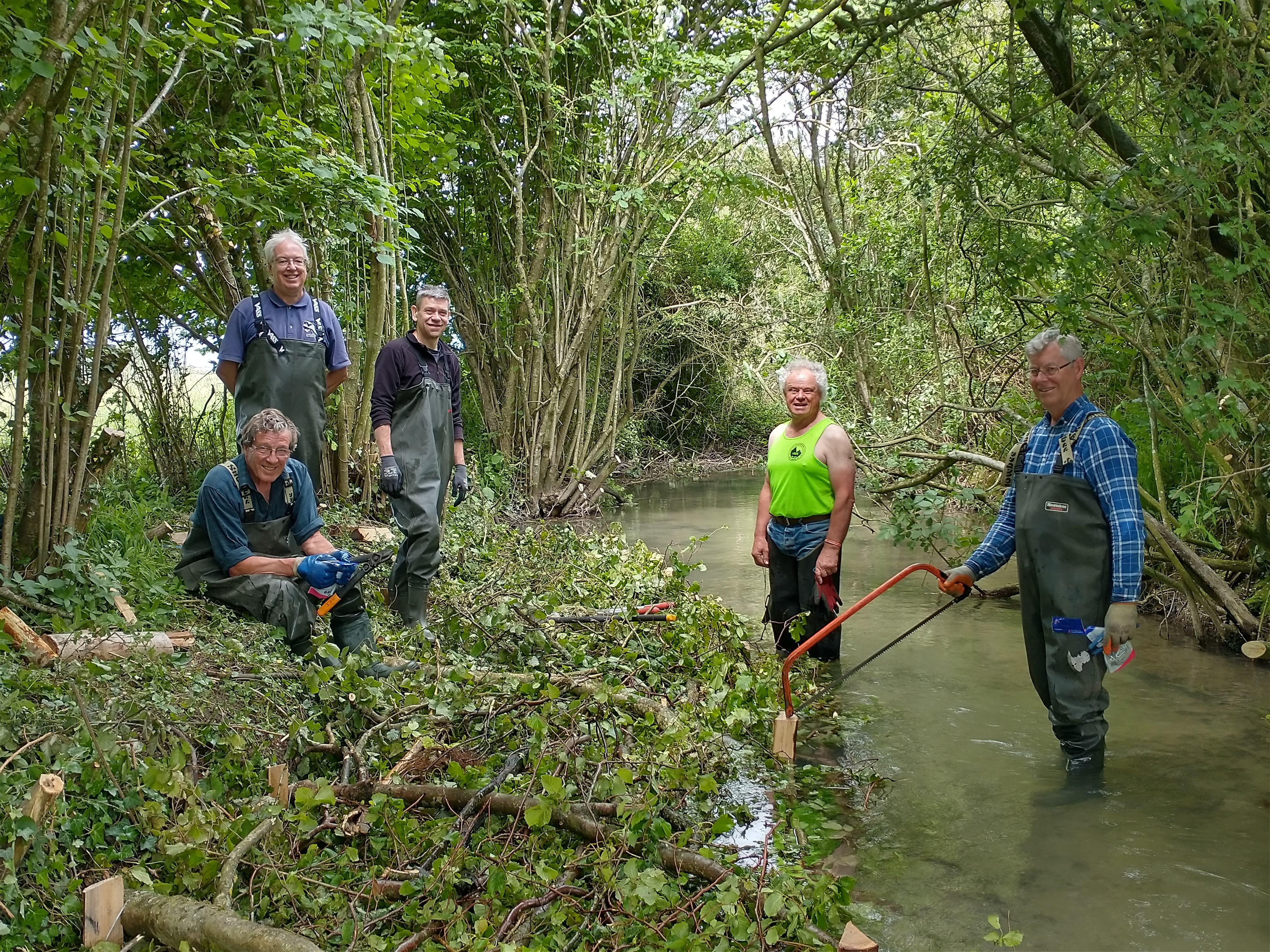Overview
The Sparkling Streams Project (SSP) took place in the Kennet River catchment.
Developed and led by North Wessex Downs National Landscape, it is a partnership together with Hungerford Town and Manor, ARK – Action for the River Kennet, and the Southern Streams Farmers Group.
The aim was to use a catchment approach improving the condition of the River Kennet chalk river (Site of Special Scientific Interest, or SSSI) and the Shalbourne and Dun tributaries, increasing wildlife, and connecting people with nature.
The SSP delivered work ranging from large-scale river restoration/reconnection on the River Kennet to a wealth of smaller-scale works along the Dun and Shalbourne tributaries, engaging farmers, local communities, and school children.
SSP has had a big impact and is an exemplar model that can be replicated on other rivers/streams/sub-catchments.
It was a great blend of delivering substantial nature recovery gains and fostering engagement with local communities, individuals and farmers.

Courtesy of North Wessex Downs National Landscape
What was done
Using this catchment-based approach, the SSP aimed to improve the condition of the River Kennet and Shalbourne and Dun tributaries, increasing wildlife and connecting people with nature.
SSP used nature recovery and nature-based solutions to address the problems with the river and its catchment; with the outcomes contributing to the overall vision for chalk streams and the people who live near them.
Achieving the nature recovery and nature-based solutions relied on people helping with the work and learning to love and care for the future of their chalk streams.
The SSP connected people with nature by delivering volunteer tasks, public outreach, and schools work.
The project set out to:
- Provide a varied range of volunteering opportunities
- Work with a school to create a raingarden and school activities
- Deliver public outreach
- Encourage peer to peer learning for farmers
- Restore natural river processes and fish passage
- Restore river habitat (Shalbourne and Dun tributaries)
- Improve the wider river catchment habitat
This work increases water flows, helps improve water quality, improves fish passage and migration, slows overland flows, reduces soil erosion, increases biodiversity in the rivers and across the catchment, and mitigate against climate change.
All these nature-based solutions help nature on its path to recovery.
The nature recovery and nature-based solutions carried out by the SSP included:
- Creating wetlands and fish passages
- Restoring water channels
- Planting hedgerows and woodland
- Habitat works in the river and wider catchment
- A raingarden
- Feasibility studies and designs for future enhancements.
The main objectives of the Eddington Mill River Restoration element were to:
1. Reconnect the historic river channel at Eddington Mill to provide 500m of new fish passage and increase floodplain activity.
2. Enhance the main river Kennet channel at Eddington Mill to increase flow and habitat diversity, increase floodplain connectivity and enhance riparian habitats.
Despite Covid-19 being present throughout the project, as most of the activities were outside, the Sparkling Streams team were able to put safety measures into place, and people felt safe to come and get involved.
In total over 381 adults and 60 children people got involved directly with Sparkling Stream activities.
Many more were informed and engaged through communications, websites, newsletters, and social media.
145 individuals volunteered for SSP, giving over 1600 hours of their time between April 2021 and March 2022.
Of these, 94 were new to ARK.
Courtesy of North Wessex Downs National Landscape
Outcomes
Just a few of the Sparkling Streams Project highlights:
- 1.1km of new and enhanced chalk stream – reinstating a historic channel to enable fish passage for the first time since C13th/C14th at Eddington Mill on the River Kennet SSSI.
- 3km of enhanced in-river, and riparian habitat work carried out on 8 sites of the Dun and Shalbourne tributaries.
- 1km hedge (5,425 hedge plants) and 6ha woodland (3401 trees) planted on 6 sites.
- 64 Volunteer tasks were held; 145 people gave over 1600 hours of their time. 94 people were in addition to Action for the River Kennet volunteers.
- 478 people involved or engaged in activities.
- A raingarden created at Shalbourne Primary School.
- 381 adult- and 60 child-attended activities.
“As a farmer, to see volunteers and people coming out and helping is amazing, getting connected with your landscape is a big thing. Having people understanding what farming is and what it’s doing, is a massive positive thing. The work in the rivers is amazing, re graveling riverbeds, opening up parts of the river that haven’t seen sunshine for many years."
Tom Beese, farmer.
Learnings
The key to success was a strong shared vision and a clear understanding that this project would not succeed without being able to engage local communities and volunteers, the village school and Southern Streams farmers.
Regarding the sub catchment holistically and being able to convey the impact that individual actions would have on the quality of the rivers and their riparian habitats.
Other reasons the project delivered more than expected include:
- A dedicated, hard-working and dependable partnership.
- Recruitment of skilled, talented and diligent staff.
- Skilled and flexible National Landscapes team, providing the project administration and communications support.
- Enthusiastic and supportive farmers and riparian owners.
- Appreciative & encouraging communication.
- Procurement of highly proficient and expert contractors.
- Substantial cooperation of staff, parents and children at Shalbourne School.
- Hard work and enthusiasm of Sparkling Streams volunteers
The partnership has strengthened during the project and partners have found other work to collaborate on and are discussing future partnership working.
Everyone who has worked on the project has gained skills and knowledge whether directly about chalk stream management, or indirectly about funding, project management and partnership working.
By connecting people with nature, the Sparkling Streams Project leaves a legacy of happier, healthier adults and children who understand and care for chalk streams and their wildlife; more farmers encouraged to reduce farm pollutants reaching the chalk streams, and the basis for future funding for river habitat restoration.
